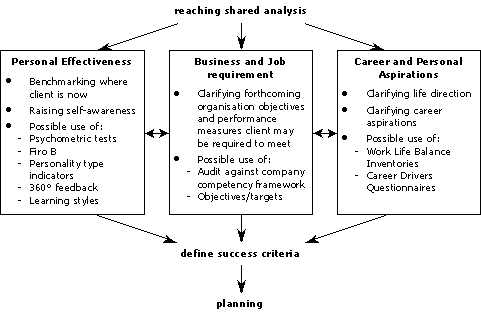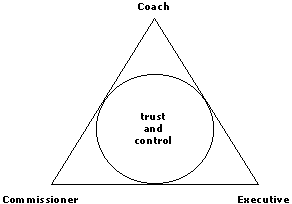Report summary: Executive Coaching: Inspiring Performance at Work
Executive coaching is largely an import from the US, and has been sweeping the boardrooms of Europe over the last few years. It is arguably now the ‘hot topic’ in many organisations for meeting senior management development needs, spanning business, functional and personal skills. Yet the issues arising from this expensive process have until now been little explored. Here is an informative overview for organisations.
Executive coaching is an import from the US that has grown enormously in popularity across Europe in the last few years. Fees for executive coaches of around £2,000 per day are not uncommon. This compares with an average daily fee of £975 per day among UK management consultants. The research was undertaken because of the increasing interest, cost, and use of executive coaching, and because relatively little appeared to be known about what the issues were for organisations.
What is executive coaching?
Executive coaching is an interactive process that is designed to help individuals to develop rapidly. It is usually work related and focused on improving performance or behaviour. It is a goal-orientated form of personally tailored learning for a busy executive.
The essential features of executive coaching are that it is a short-term, time limited, paid for, goal specific, action orientated, personally tailored approach to learning. It utilises feedback and offers some objectivity.
The study found considerable confusion in organisations about the differences in theory and in practice between the ‘labels’ of executive coaching, mentoring and a range of other one to one support processes. Our report differentiates executive coaching from mentoring, organisation development, counselling, and psycho-therapy.
Why do employers use it?
What motivates employers to commission executive coaching? What is it they hope to gain? Our study found five main motives for organisations in introducing executive coaching. These were categorised as:
- to support the induction or appointment of a senior person into a more senior, or different role
- to accelerate the personal development of individuals defined as ‘high potential’, or individuals from a minority group identified for affirmative action
- to underpin the effective implementation of organisation change, through supporting teams and individuals
- as a critical friend or independent sounding board to a senior individual
- to support senior individuals engaged in wider personal effectiveness programmes, such as 360-degree appraisal or development centres.
These categories are illustrated in the report by the use of real case examples or ‘vignettes’ from organisations. One further category, or motive, was suggested as possible, although it was not encountered in this study:
- as a means of rewarding and retaining key staff critical to the business.
The reasons for the phenomenal growth in the use of executive coaching by employing organisations may include:
- the knock-on effects of the downsizing of the 1990s, resulting in ‘lonely’ and isolated senior managers who welcome support and challenge from someone external to their immediate work environment.
- the increasing demand by organisations for senior managers with key ‘soft skills’. Many business schools and in-company standard development programmes have failed to embed the kinds of feedback-based approaches necessary for self-insight and the acquisition of soft skills, for managers when they were more junior.
- Some senior managers consider they have ‘made it’ and worry that being seen to undergo development may be perceived by others as admitting they have a weakness. The nature of the executive coaching relationship is private and avoids that public gaze.
- Attendance on whole-day courses or regular learning sets can seem an imposition into an already busy schedule. Sessions with executive coaches can be fitted around other diary commitments.
The executive coaching process
The study enabled the process from the executive coaches’ perspective to be identified. Six main phases within the overall process were evident. These were:
- entry and contracting with the individual
- identifying the issues to be addressed
- reaching a shared analysis
- planning to address development needs arising
- action taking, practice and reflection
- withdrawal from the relationship.
Figure 1 outlines the key phase of reaching an analysis, shared by the coach and coached, whereby coaches were found to focus on one or more of three key paths. IES has termed the three paths as those of personal effectiveness, business and job requirements, and career and personal aspirations. All of the coaches interviewed in the study, however, gave at least some consideration to all three aspects.
Figure 1: Behind reaching a shared analysis

Source: IES
Issues to consider
The study identified a range of implementation issues from the perspective of employing organisations using, or planning to use, executive coaching. This includes practical considerations that need to be taken into account, whether the intention is to source the executive coaches externally or internally. In particular, the report of the study has:
- identified a range of backgrounds and professional training of coaches, and the implications that this has for the underpinning conceptual framework or approach they bring to providing their services
- recommended having a process in place to maximise the chances of a successful ‘match’ between the individual manager and the coach
- highlighted the existence of ‘coaching envy’ (whereby having an executive coach is seen as such a positive activity that everyone else wants one) and the potential need to manage the demand for executive coaching
- shared some of the experiences of the organisations participating in the study, regarding the cost of commissioning external executive coaches
- highlighted the problems inherent in evaluating the impact of this type of development process involving close one-to-one collaboration
- explained the ‘relationship triangle’ (see Figure 2 below) between the commissioner, executive and the coach. It has offered some insight into the underlying issues of trust and control which need to be present in order to maximise the success of the executive coaching from each of the three perspectives.
Figure 2: The executive coaching relationship ‘triangle’

Source: IES
IES Research Networks
With the aggressive marketing of executive coaching by consultants, it is becoming increasingly difficult to obtain an objective view about what it is, and about the issues to consider when using it. This initial exploratory study was sponsored by the IES Research Club, a group of 30 of the UK’s leading employers who help to shape an ongoing programme of topical research. Several member organisations collaborated and participated in the study.
This work builds on previous IES research into management development and the role of senior managers.
Get the report
Executive Coaching: Inspiring Performance at Work, Carter A. Report 379, Institute for Employment Studies, 2001.
ISBN: 978-1-85184-308-4. PDF Download only: £free

